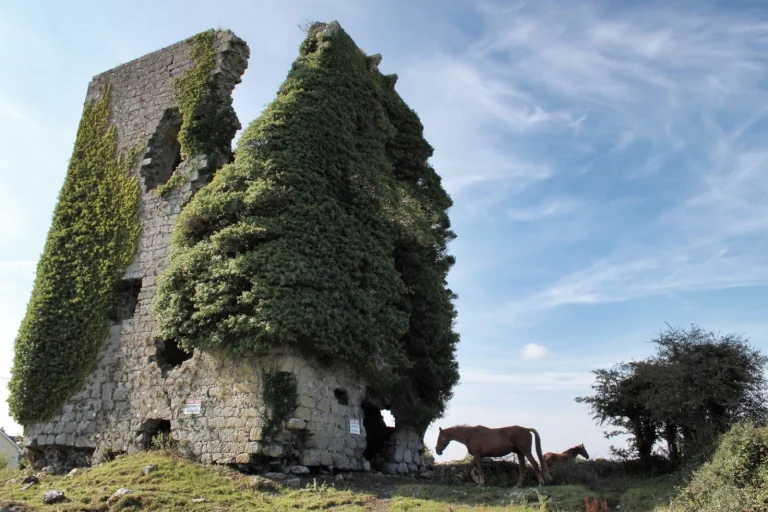
Imagine a stone, standing silently for over 2,000 years, its surface etched with swirling, mystical patterns. This isn’t a scene from a fantasy novel; it’s the reality of the Turoe Stone, one of Ireland’s most captivating and mysterious archaeological artifacts. Located in the heart of County Galway, this magnificent piece of Iron Age art holds a special place in Ireland’s history and cultural landscape.
In this comprehensive blog, we’ll journey back in time to uncover the Turoe Stone’s history, delve into its fascinating purpose, and provide you with all the essential information for a visit. Whether you’re a history buff, a curious traveler, or an art enthusiast, the Turoe Stone has a story to tell.
The Story Carved in Stone: Turoe Stone History and Facts
The Turoe Stone is a granite boulder, standing just under a meter tall, and is celebrated as one of the finest examples of La Tène art in all of Europe. The La Tène style, a characteristic of Celtic art during the Iron Age, is known for its intricate, flowing, and curvilinear designs. The Turoe Stone’s surface is a masterpiece of this style, featuring a complex pattern of spirals, trumpet motifs, and “pocked” relief work.
It’s believed that the stone was carved sometime between 150 BC and 100 AD, a period of immense cultural and social change in ancient Ireland. Its presence marks a significant era when Celtic art flourished, and its survival to this day is a testament to the enduring craftsmanship of our ancestors.
The Turoe Stone facts are as intriguing as its design. For centuries, it was located at an ancient ringfort, known as the Rath of Feerwore, near the village of Bullaun. In the 19th century, it was moved to the lawn of Turoe House, giving it the name by which it is now universally known. This move, while well-intentioned at the time, has been a subject of debate among archaeologists, as it separated the stone from its original historical context.
The stone is not just a relic of the past; it’s a window into the artistic and spiritual life of the Iron Age Celts. Its design is both beautiful and enigmatic, sparking endless theories and interpretations.
Your Questions Answered: FAQs About the Turoe Stone

We know a monument this mysterious comes with a lot of questions. Here are the answers to the most frequently asked questions about the Turoe Stone.
What is the function of the Turoe Stone?
The exact function of the Turoe Stone is a subject of ongoing debate among archaeologists and historians. Its unique design and location suggest it was a sacred or ritual object. Theories include:
- A Boundary Marker: The stone could have served to mark a territorial boundary or a sacred space.
- A Ritual Stone: It may have been a focus for pre-Christian religious ceremonies, such as inauguration rituals for Celtic kings or fertility rites.
- A Votive Object: The stone might have been a symbol of a deity or a place for offerings.
While its true purpose remains a mystery, it is clear that the Turoe Stone held immense spiritual and cultural significance for the people who created it.
Where is the Turoe Stone located?
The Turoe Stone is located in County Galway, Ireland, near the village of Bullaun. For many years, it was situated in a protective enclosure on the lawn of Turoe House, which is adjacent to the popular Turoe Pet Farm. However, in 2023, the stone was removed for conservation work and to be placed in storage. The plan is for it to be returned to a new, purpose-built enclosure at its original location near the Rath of Feerwore. So, the question of “Where is the Turoe Stone now?” has a temporary answer: it is in state care for its preservation, with plans for its return to Bullaun.
What type of stone is Turoe Stone made of?
The Turoe Stone is made of granite. The fact that it’s a granite boulder, and not a stone quarried from the immediate area, adds another layer of mystery to its origins and transport. The artisans of the Iron Age were clearly skilled in working with this hard and durable material.
How old is the Turoe Stone?
Archaeologists estimate the Turoe Stone to be between 2,000 and 2,200 years old, dating to the late Iron Age. This places its creation in the period from roughly 150 BC to 100 AD, a time just before the arrival of Christianity in Ireland.
Who owns the Turoe Stone?
The Turoe Stone is a designated National Monument of Ireland and is therefore owned and cared for by the state. Specifically, its custodianship falls under the Office of Public Works (OPW) and the National Museum of Ireland. They are responsible for its preservation and protection for future generations.
How to use a prayer stone?
This question is not directly related to the Turoe Stone, but it is a common query related to sacred stones. While the Turoe Stone’s function is unknown, and it is not a “prayer stone” in the modern, personal sense, other stones have been used for spiritual purposes. A personal prayer stone is typically a small, smooth stone held in the hand during meditation or prayer to help focus one’s thoughts. The Turoe Stone, with its monumental size and complex design, was likely a communal religious focal point, not an individual one. If you’re interested in learning more about this topic, you can find a wealth of information online and in spiritual texts.
How did the Turoe Stone get its name?
The Turoe Stone takes its name from the townland of Turoe, where it has been located for over a century on the grounds of Turoe House. The name “Turoe” itself is an anglicisation of the Irish “Tuairín”, meaning “little green hill”.
Where are the sacred stones?
Sacred stones, from standing stones and stone circles to carved ritual stones, are found all over Ireland and indeed, all over the world. The Turoe Stone is just one of many examples of decorated stones from the Celtic Iron Age. Other notable examples in Ireland include the Castlestrange Stone in County Roscommon. Many of these stones are part of our extensive collection of information on Irish landmarks. You can explore more about Ireland’s fascinating ancient stones right here: https://secretireland.ie/?s=stone.
Is the Turoe Stone a national monument?
Yes, the Turoe Stone is a designated National Monument of Ireland. This status ensures its legal protection and preservation by the state, recognizing its profound historical and cultural importance.
Planning Your Visit to the Turoe Stone and Turoe Pet Farm
A visit to the Turoe Stone is often combined with a trip to the nearby family-friendly attraction, Turoe Pet Farm. Here’s what you need to know to plan your day.
Getting There: Turoe Stone Galway
The Turoe Stone is located in a rural part of County Galway, approximately 40 minutes from Galway City.
- By Car: Driving is the easiest way to reach the site. From Galway, take the M6 motorway towards Dublin, then take the exit for Loughrea. The stone is well signposted from the village of Bullaun. For Turoe Pet Farm directions, you can follow the signs from the village, which is also clearly marked on GPS.
- Public Transport: There is no direct public transport to the site. A bus to Loughrea and then a taxi would be required, but a car is highly recommended for flexibility.
Turoe Pet Farm Prices and Opening Hours
A visit to the Turoe Stone itself has no Turoe Stone price as it is a public national monument. However, access to the stone has historically been via the grounds of Turoe Pet Farm.
- Turoe Pet Farm prices vary, with rates for adults and children, as well as family discounts. It’s always best to check the official Turoe Pet Farm website for the most up-to-date pricing before you go.
- Turoe Pet Farm opening hours are seasonal. It is generally open daily during school holidays and on weekends. Opening hours can change, so always check the website for the latest information.
An Unforgettable Journey Through Time
The Turoe Stone is more than just a lump of granite with pretty patterns. It is a tangible link to our ancient past, a symbol of the artistic genius of the Iron Age Celts, and a source of enduring mystery. To stand before this stone is to feel a connection to a world long gone, a world of ritual, belief, and profound artistic expression.
While you’re exploring the wonders of Galway, don’t forget to visit Dunguaire Castle, a stunning fortress that offers a different, yet equally captivating, glimpse into Ireland’s rich history. You can find your essential guide to this Galway fairytale fortress here: https://secretireland.ie/dunguaire-castle-your-essential-guide-to-galways-fairytale-fortress/.
Whether you’re visiting the stone itself or exploring the enchanting landscapes of County Galway, you are walking in the footsteps of history. The Turoe Stone stands as a testament to the fact that some stories, no matter how old, continue to resonate, inviting us to ponder their secrets and marvel at their beauty.
For more information on incredible castles, stones, and hidden gems across Ireland, visit our website: https://secretireland.ie/?s=castles and https://secretireland.ie/?s=stone.



